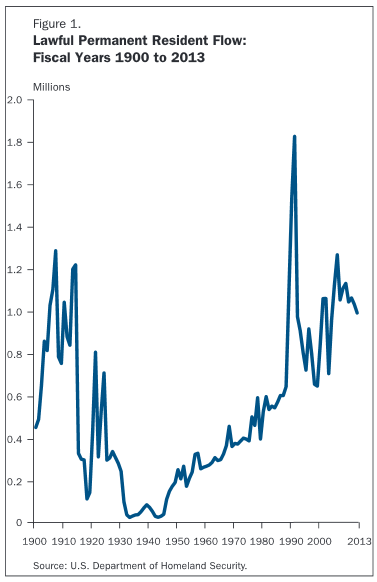Rick Santorum said that the United States is “accepting more legal immigrants than we ever have.” Actually, the number of people being granted lawful permanent resident status has decreased consecutively for two fiscal years.
In 2013, there were 990,553 foreign individuals who became lawful permanent residents of the United States, or “green card” holders, according to figures from the Department of Homeland Security. That’s a 4 percent drop from the 1,031,631 people obtaining LPR status in 2012 and a near 7 percent decline from the 1,062,040 who obtained such status in 2011.
The historical high for lawful immigration was back in 1991, when 1,826,595 people obtained permanent resident status, which DHS attributes to the legalization of 2.7 million previously unauthorized immigrants under the Immigration Reform and Control Act of 1986.
Santorum, a former U.S. senator from Pennsylvania who ran for the Republican presidential nomination in 2012, made the claim on NBC’s “Meet the Press” during a roundtable discussion on immigration.
Santorum, July 13: First off, we are accepting more legal immigrants than we ever have in the history —
Detroit Free Press Editorial Page Editor Stephen Henderson: From some countries.
Santorum: It’s all chain immigration. And it’s from the very countries that people have been coming from, because most of the immigration is tied to people who are already here.
 As this DHS chart illustrates, the general trend has been an increase in LPR admissions since the mid-1940s. However, the data behind the chart show that, more recently, fewer people were granted permanent resident status in 2013 than at any time since 2004. And historically speaking, beyond the peak years of 1990 and 1991, there were more people who gained LPR status in 1905, 1906, 1907, 1910, 1913 and 1914, than did so in 2013.
As this DHS chart illustrates, the general trend has been an increase in LPR admissions since the mid-1940s. However, the data behind the chart show that, more recently, fewer people were granted permanent resident status in 2013 than at any time since 2004. And historically speaking, beyond the peak years of 1990 and 1991, there were more people who gained LPR status in 1905, 1906, 1907, 1910, 1913 and 1914, than did so in 2013.
Admission Categories
But Santorum’s other point, that “most of the immigration is tied to people who are already here,” is accurate, although he originally erred by saying that all of the legal immigration was “chain immigration.”
Family-sponsored immigrants, or so-called “chain immigrants,” represented almost 66 percent of the lawful permanent residents admitted in 2013. Of those, more than 44 percent were of immediate relation — spouses, parents, children — to U.S. citizens.
The other main LPR admission categories in 2013 included employment-based preferences (16.3 percent), refugees and asylees (12.1 percent), and diversity programs (4.6 percent).
So not all of the new lawful permanent residents gained that status based on a family relation to someone already living in the United States.
— D’Angelo Gore